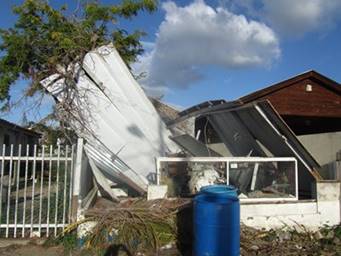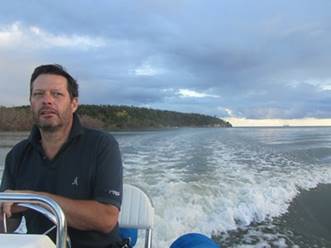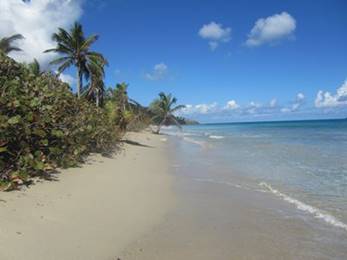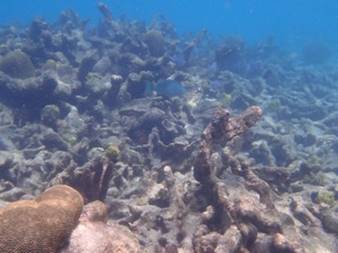Puerto Rico. February, March 2018

Puerto Rico, February/March 2018 Friday 16 February 2018, Casa De Campo (Dominican Republic) to Ponce (Puerto Rico), 155 miles, 29.5 hrs, 26.4 engine hrs 5.25 knots average speed. Total Miles since leaving Falmouth in August 2016: 10225.4 Most of our travelling along the South coast of Dominican Republic was against the trade winds which was to be expected. What wasn’t to be expected however, was the consistently high strength of these winds. There seemed to be no let up and this continued on into Puerto Rico. An abnormal season by all accounts; a constant battle to get anywhere and often uncomfortable sailing, with the necessary assistance of the motor, punching into rough seas. We had no choice but to continue in this direction, just had to pick our moments, waiting for the wind to abate even if just slightly (maybe 20 knots from 30!). We waited and waited for a suitable weather window to cross the Mona Passage, the notorious body of water that funnels between Dominican Republic and Puerto Rico, that can be extremely rough in adverse conditions. Eventually it came, or so we were lead to believe by the forecast, 17 knots gusting 20. Not great, but better than it had been and better than what was forecast to come. It turned out to be high 20’s gusting 33, with large, choppy seas, both wind and waves against us. The crossing was one of the worst passages I have experienced to date, not helped by the fact our engine cut out again, right in the vicinity of two large cargo ships turning to go up the Mona Passage. We suspected something in the fuel had been shaken up blocking the intake. Without the engine and with reefed sails we made very little headway. It was like being on a hyperactive rocking horse! One enormous ship came within ½ mile of us, too close for comfort and a superyacht altered course to avoid us. They must have wondered why we suddenly went from 5 knots to 2!! Eventually we got our engine started, the process accompanied by a few choice words, but had to hand steer as our auto pilot was making horrendous grinding noises; hardly surprising considering its age and the strain it was under. (New parts are on order, some being delivered to St Thomas in a couple of weeks, some being brought out to St Martin, from the UK, by a visiting friend). We were consequently shattered, but extremely relieved to arrive at Ponce Harbour. We called Customs and Immigration and although their offices were closed until Monday, they gave us permission to go ashore provided we stay within the vicinity of Ponce. Our priority was to find someone who had the equipment to clean our fuel, which we did, however, the person was taken ill so it didn’t materialise. It was very windy in the harbour, so much so that we rescued a canoeist and a dinghy sailor who couldn’t compete with the wind strength, towing them back to safety with our dinghy. We did some repairs, met a German couple (Reinheart and Anna, sailing yacht Sancara) and a couple from The Isle of Man (Terry and Fiona, sailing yacht Sisu) with whom we enjoyed sundowners. The huge piles of boat wreckages on shore plus the destroyed boats in the harbour were quite a shock. It was the first real hurricane devastation we had witnessed. Hurricanes Irma and Marie had certainly taken their toll. There was a sea of blue tarpaulin throughout the towns serving as temporary roofs upon many trashed houses.
A brief drop in wind strength! Looking towards marina Fixing the torn sail bag
Tarpon – enormous fish, too bony to eat Pelican watching the Tarpon
Hurricane damaged boats, heart-breaking to see. We checked in with Customs and Immigration on the way to visiting the lovely town of Ponce.
Salinas, our next port of call, 25 miles East along the South coast of Puerto Rico. The hurricane damage here was even more evident with more houses, more boats and the marina totally trashed.
We hired a car to visit the capital San Juan on the North coast; a beautiful old town with its historic buildings, sculptures and fort still standing, fortunately.
The return route took us along the coast road and through the El Yunque rain forest to the waterfall. Most of the roads in the rain forest were still closed due to fallen trees and electric cables, from the hurricane. It was noticeable how quickly the greenery had returned.
The drive back was pretty horrendous. It was getting dark. On the 3-lane main roads the traffic lights were down, there were no road markings and the pot holes so frequent and ginormous every time we hit one the windscreen wipers came on! The windscreen washer bottle was empty, the screen was filthy making visibility nigh on impossible. This coupled with the completely ignored road rules and maniac drivers made for a very nerve racking road trip! To add insult to injury, we acquired a puncture. Undoing the wheel nuts to put on the spare was impossible. We limped to a garage that, although closed, fortunately had someone still there who kindly assisted us with the appropriate tools getting us back on our way. It was a very long 50km back to the marina bar, where we met two couples also sailing East; Ken and Sue (Whiskey Jack) and Brian and Nancy (Seabird). Seabird had miraculously survived the hurricane! Following a couple of days of never ending boat maintenance we headed overnight to the Puerto Rican island of Vieques, Mosquito Bay, reported to possibly be the largest bio-bay (bioluminescent / phosphorescent) bay in the World. Securely anchored we launched the dinghy and explored the area, getting our bearings for our later after dark expedition. A good few hours after sunset, with a powerful torch, we excitedly set off in the dinghy in search of the ‘shimmering’ mass. Engines are not permitted so on approaching the bay entrance we switched off and paddled. There was not a sound and soon we discovered there wasn’t any bioluminescence either. Not one single little sparkle. We’d seen more in the marina at Falmouth in the UK! Later we discovered the hurricane had had an impact on the bay plus the moon was possibly too bright.
On Thursday 1 March we arrived at the Puerto Rican Island of Culibra, Dewey Town, Ensenada Honda. We left Mosquito Bay at 0340 hrs having given up on the possibility of any sleep due to the large swell coming into the bay causing the boat to roll from side to side. When she rolls she creaks and squeaks, loudly and annoyingly, like a million creaky floor boards rolled into one and being stepped on every couple of seconds! We felt like giant metronomes without an off switch. At least once out of the bay the sea was relatively flat and the night wind gentle for a change.
Culibra is a wonderful island that can be toured by golf cart easily in a day. It too has suffered Mother Nature’s cruelty. Trees were down, properties destroyed, enormous amounts of coral killed and washed up on the beautiful beaches and two huge generators were supplying electricity to the island whilst the power station was being restored. A lot of cables were still down, strewn along the roadsides. We took it in turns to drive the golf cart from one end of the island to the other, stopping at the various landmarks! Some of the tracks were narrow and steep making driving interesting and fun. The museum showed a film of how in World War II, the US Navy used Culibra as target practice, accidentally killing some of the locals! Snorkelling was disappointing due to poor visibility from the high winds disturbing the sea bed, but still welcome giving us chance to cool off! We did see one solitary turtle and a few fish in the haze, but all the dead coral looked like and underwater ghost town. Very sad. One road was cordoned-off due to the discovery of an unexploded bomb that morning! The views from higher up were spectacular, across to Puerto Rico and the US Virgin Island of St Thomas.
Zoni Beach Museum
Yachts Seabird and Whiskey Jack, whom we’d met in Salinas had also arrived so we shared sundowners then a meal at Zaco’s Tacos. We don’t eat out often, so it’s always a welcome treat 😊. Next stop, St.Thomas, US Virgin Islands. |





 Fixing the windlass electrics and the autopilot with Terry from Sisu
Fixing the windlass electrics and the autopilot with Terry from Sisu




































































